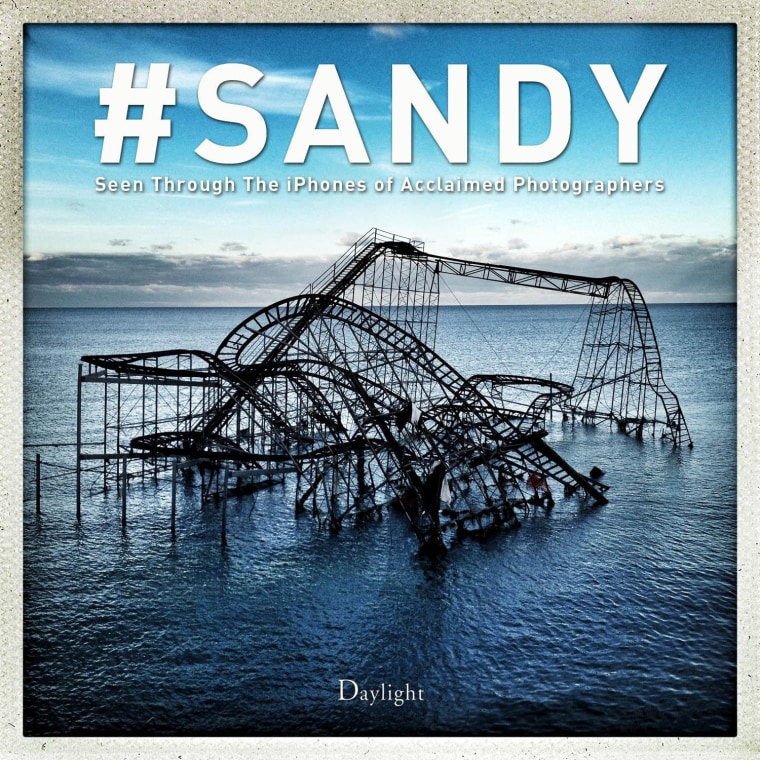Cell phones and social networks are great tools to quickly push images and information to large audiences, but they haven’t proven their utility for creating a lasting archive. Photographer Wyatt Gallery is spearheading a book that just might change that.
"#SANDY" is a collection of iPhone photographs taken by numerous professional photographers during last year’s superstorm. Gallery started an Indiegogo campaign to fund the book he edited, with net proceeds and royalties going to Occupy Sandy, a group affiliated with Occupy Wall Street which aims to help victims of the storm.
Gallery talked to NBC News via email in the Q&A below, which has been edited for length.
Where did the idea for the book come from?
While photographing the aftermath of Hurricane Sandy alongside my fellow photographers Benjamin Lowy and Ruddy Roye, who were shooting for TIME and The New Yorker's Instagram feeds, I followed their lead and left my DSLR camera at home in order to be more mobile and to be able to post photographs in the moment from my iPhone through Instagram. I quickly realized how powerful this combination was because my followers began to ask me, "How can I help? Where can we volunteer?" My photographs began to make a difference immediately.
While driving home from Rockaway one day, I said to Ben and Ruddy, "Hey we should do an exhibition of these photos and use them to raise money." Less than three weeks later, we showcased 150 8”x8" iPhone photographs at the Foley Gallery in New York City and sold them for $50 each. The turnout was amazing and we were able to donate $19,000 to Occupy Sandy and Third Wave Volunteers.
After the event, someone said to me "You should really publish a book of these images." That idea stayed in the back of my mind for months. I began to really pursue it by contacting other acclaimed photographers like Richard Renaldi, Stephen Wilkes, Ed Kashi and Lyle Owerko. Everyone loved the idea.
But the book really came to fruition when Sean Corcoran, curator of prints and photographs at the Museum of The City of New York, invited me to meet with him about exhibiting my iPhone photographs in a Sandy Exhibition they are showing in November 2013. I told him about the idea and he really believed in it and said he would write an essay and help select the images. So I jumped all in at that point and began to produce the book.
Why publish a book after many of the photos were exhibited in the gallery?
Our exhibition of #SANDY was only up for one night at Foley gallery and another week online. A book is a part of history and lasts forever, thus it can continue to remind people of this tragedy and the massive loss that many of our neighbors experienced. Our goal is to raise more awareness that many New Yorkers are still in need of assistance one year after Hurricane Sandy. So the book is a way to get thousands of new people to be reminded of this and support Occupy Sandy's efforts.
Do you find it ironic to create a physical book from iPhone photos, with “new media” being published in “old media”?
I love that we are publishing "new media" in an "old media" format! This is the beauty of the time we are in. Everything is being used at the same time simultaneously. But there is a very real reason to publish these iPhone photos as a printed book. Through my last book, "Tent Life: Haiti," we were able to use the book as a tool to raise even more money by arranging a traveling exhibition and multiple events. The book is a solid object that you can hold, feel and page through over and over. It exists in your physical world and your personal space in a way that it's more "in your face" without even having to turn it on or open it. A computer, TV or smartphone is like a trunk; you can't see what's in it unless you open the trunk, or turn it on. [A book] becomes a very solid part of history and makes a difference without effort.
Why use iPhone photos when, I’m guessing, most of the photographers were shooting with pro cameras at the same time?
The iPhone is a powerful tool because it's always on you, and you can post the photos in real time so that thousands or millions of other people can witness the situation instantly. Versus a DSLR camera where you need to download the photos to your computer before you can upload them to the Internet. Photographers like Benjamin Lowy and Michael Christopher Brown are well known for using their iPhones as their main camera for photojournalistic coverage of wars in Africa and the Middle East. It's our most powerful weapon.
Many of these photographers were assigned by TIME magazine to shoot for their Instagram feed, so not all of the photographers were using DLSR cameras.
Visit Indiegogo to donate to #SANDY and preorder a signed copy of the book, which will be delivered to supporters in November 2013.
